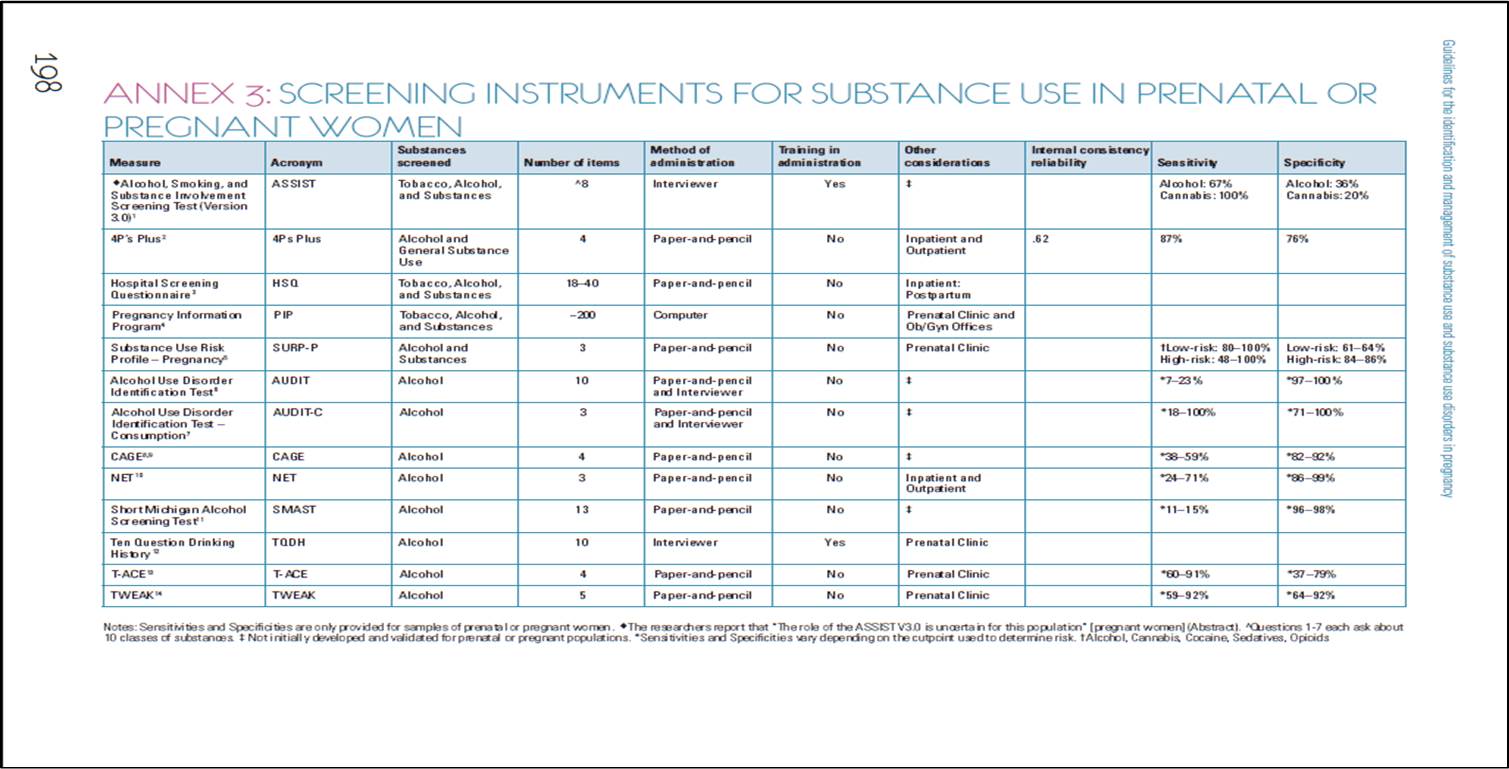Screening instruments for substance use in prenatal or pregnant women

1 Hotham E, Ali R, White J, Sullivan T, Robinson J. Investigation of the Alcohol, Smoking, and Substance Involvement Screening Test (the ASSIST) Version 3.0 in Pregnancy. Addict Disord Their Treat 2013, 12(3), 123–135.
2 Chasnoff, I. J., McGourty, R. F., Bailey, G. W., Hutchins, E., Lightfoot, S. O., Pawson, L. L., et al. (2005). The 4P's Plus screen for substance use in pregnancy: clinical application and outcomes. J Perinatol, 25(6), 368-374.
3 Streissguth, A. P., & Giunta, C. T. (1992). Subject recruitment and retention for longitudinal research: Practical considerations for a nonintervention model. In M. M. Kilbey & K. Asghar (Eds.), Methodological Issues in Epidemiological, Prevention, and
Treatment Research on Drug-Exposed Women and Their Children Rockville: NIDA Monograph No. 117 (137-154) US DHHS Public Health Services.
4 Lapham, S. C., Kring, M. K., & Skipper, B. (1991). Prenatal behavioral risk screening by computer in a health maintenance organization-based prenatal care clinic. Am J Obstet Gynecol, 165(3), 506-514.
5 Yonkers, K. A., Gotman, N., Kershaw, T., Forray, A., Howell, H. B., & Rounsaville, B. J. (2010). Screening for prenatal substance use: development of the Substance Use Risk Profile-Pregnancy scale. Obstet Gynecol, 116(4), 827-833.
6 Babor, T. F., Higgins-Biddle, J. C., Saunders, J. B., & Monteiro, M. G. (2001). AUDIT: The Alcohol Use DisordersIdentification Test: Guidelinesfor Use in Primary Health Care. Geneva: World Health Organization.
7 Bush, K., Kivlahan, D. R., McDonell, M. B., Fihn, S. D., & Bradley, K. A. (1998). The AUDIT alcohol consumption questions (AUDIT-C): an effective brief screening test for problem drinking. Ambulatory Care Quality Improvement Project (ACQUIP).
Alcohol Use Disorders Identification Test. Arch Intern Med, 158(16), 1789-1795.
8 Buchsbaum, D. G., Buchanan, R. G., Centor, R. M., Schnoll, S. H., & Lawton, M. J. (1991). Screening for alcohol abuse using CAGE scores and likelihood ratios. Ann Intern Med, 115(10), 774-777.
9 Mayfield, D., McLeod, G., & Hall, P. (1974). The CAGE questionnaire: validation of a new alcoholism screening instrument. Am J Psychiatry, 131(10), 1121-1123.
10 Bottoms, S. F., Martier, S. S., & Sokol, R. J. (1989). Refinements in screening for risk drinking in reproductive-aged women: The "NET" results. Alcoholism Clin Exp Res, 13, 339.
11 Selzer, M. L., Vinokur, A., & van Rooijen, L. (1975). A self-administered Short Michigan Alcoholism Screening Test (SMAST). J Stud Alcohol, 36(1), 117-126.
12 Weiner, L., Rosett, H. L., & Edelin, K. C. (1982). Behavioral evaluation of fetal alcohol education for physicians. Alcohol Clin Exp Res, 6(2), 230-233.
13 Sokol, R. J., Martier, S. S., & Ager, J. W. (1989). The T-ACE questions: practical prenatal detection of risk-drinking. Am J Obstet Gynecol, 160(4), 863-868; discussion 868-870.
14 Russell, M., & Skinner, J. B. (1988). Early measures of maternal alcohol misuse as predictors of adverse pregnancy outcomes. Alcohol Clin Exp Res, 12(6), 824-830.
- ISSUP members can join Networks to comment – Sign in or become a member